The Florida Liberty Bell replica
Rising 345 feet above sea level with 8,436 miles of coastline and a 15-to-1 human-to-alligator ratio, Florida is a bold peninsula stabbing aggressively at the world beyond. A point of entry and a release valve — it’s America to the extreme. From Citrus to Space Shuttles, hanging chads to Jan Hammer, flamingos to theme parks, Tom Petty to Florida Man, the state is full of surprises — yet somehow, nothing’s shocking.
When you think of Florida, you don’t think of the Liberty Bell. But the state has one. Every state has one. Florida actually has four Liberty Bells. There’s a water-tower-turned-museum in Melbourne with its own replica. A cemetery in Gotha has one. There’s a Liberty Bell in the center of the most magical place on earth — Walt Disney World. While it’s easy to miss amongst the throngs and thrill rides and daily parades, some 40 million visitors walk past it each year — ten times the number who visit the Liberty Bell in Philadelphia.
While Disney’s is the world’s most visited Liberty Bell, it’s not Florida’s most storied bell. That honor belongs to the state’s official Liberty Bell in Tallahassee.
The story of the Florida Liberty Bell starts 70 years ago in the nation’s capital.
In the booming post-war era, the US Treasury rebranded War Bonds as Savings Bonds, reframing their benefit from financing the war effort to preserving our collective independence. Early in 1950, the Treasury sought a campaign theme for their summer Savings Bond drive. With an ambitious $650 million sales goal, the campaign would launch on May 15th and conclude with a bang on the Fourth of July.
The 1949 campaign, branded as America’s Opportunity Drive, was a nostalgic nod to the westward migration of 1849. Gronway Parry, the Covered Wagon King, produced 26 covered wagons to be used as promotional vehicles. Festooned with the slogan, Be a Modern ’49’er, the wagons were loaded onto cargo planes and flown across the country, touring hundreds of cities and 30 of the 48 state capitals.
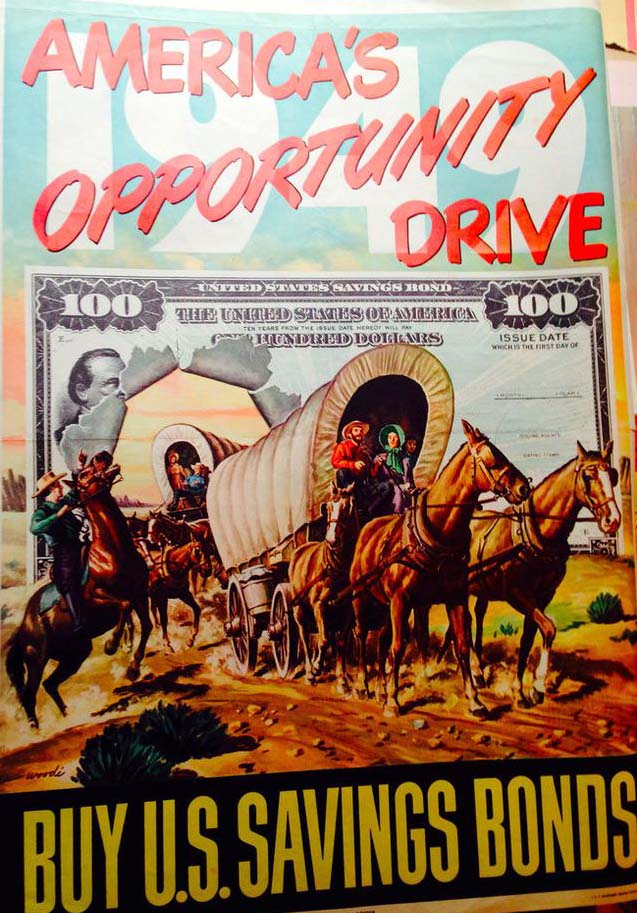
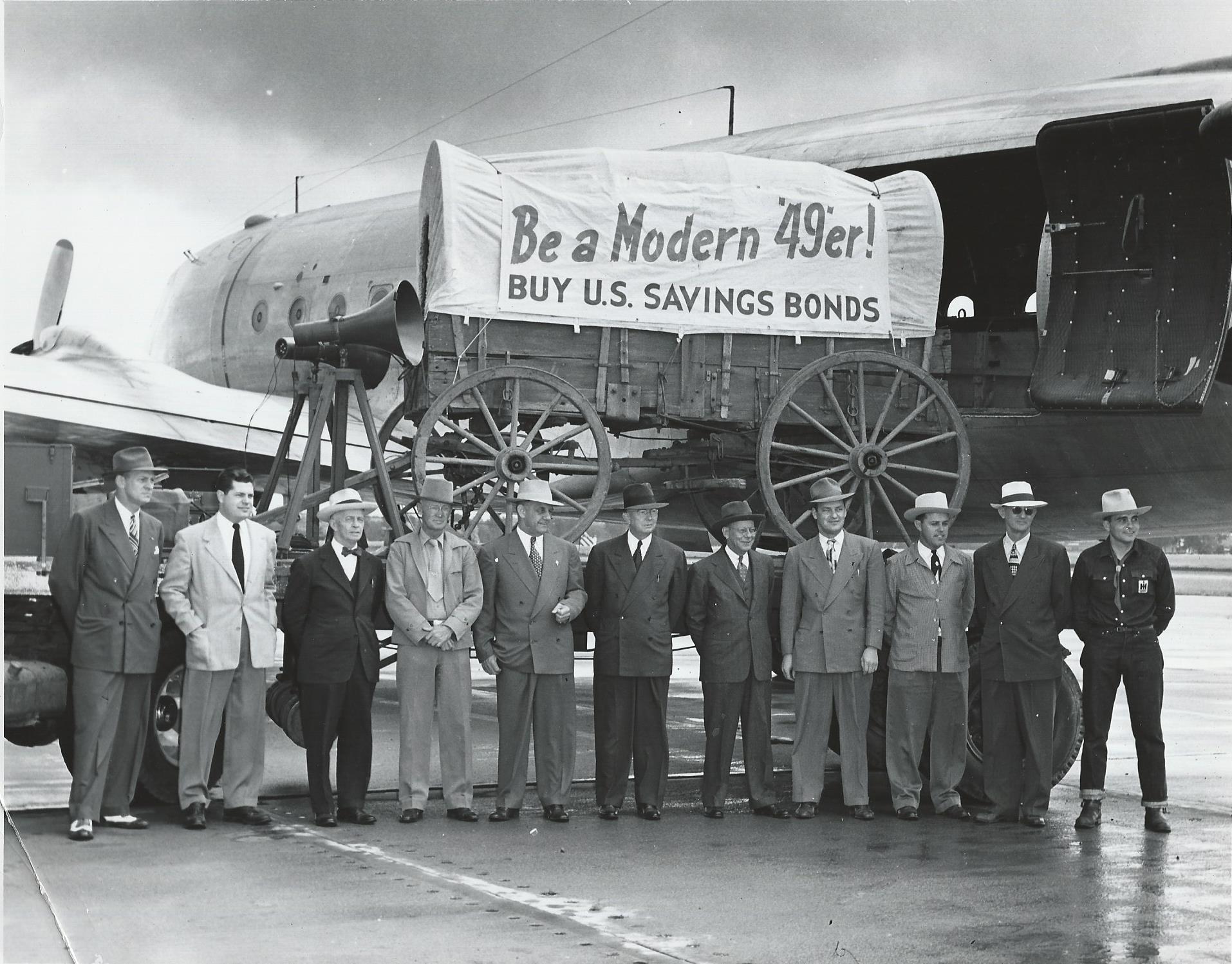
Building on the success of the 1949 campaign, the Treasury went back to the reliable well of nostalgia. This time the theme would be Save for Your Independence. Full-size, functional Liberty Bell replicas would tour each state and select territories. Buy a bond, ring the bell, save the world.
The creative brains behind the campaign were members of the Advertising Council, America’s foremost Ad Men. Formed two months after the bombing of Pearl Harbor, the council’s first charge was to promote the sale of Treasury Bonds to finance the war effort.
As the war’s end drew near, President Roosevelt sought peacetime applications for wartime inventions, including the bond drive. He requested the council continue their effort during peacetime. Now known as the Ad Council, the group went on to produce such iconic public service campaigns as the Crying Indian, Just Say No, McGruff the Crime Dog, Let’s Move, and Love Has No Labels.
Every advertising campaign comes with its own set of risks. Will your message resonate? Have you saturated the market? Will your investment pay off? At least when it came to money, the Treasury had little to worry about, not because they were in the business of printing money, but because they were very, very good at getting free stuff.
By the Treasury’s own 1961 accounting, their bond campaigns benefited from about 50 million dollars a year in pro-bono services from ad agencies and donated media from radio, television, newspapers, magazines, outdoor and transit advertising outlets. That’s $533 million in 2020 dollars. Their figure did not calculate the value of celebrity endorsements or editorial coverage, both of which they reaped in spades. The only hard costs incurred by the Treasury were for the physical artwork files and posters delivered to print outlets and advertisers.

The Treasury and the Advertising Council had everything they needed to pull off another successful campaign. Everything, that is, but the bells. And time was running short.
A loose affiliation of eight American metal companies offered to donate the most valuable commodity, the raw copper and tin to produce nearly 60 tons of bells. The American Bridge company would produce steel frames for the bells, and the Ford Motor Company pledged a flatbed truck to parade each bell throughout its respective region during the drive.
Finding a bell foundry to produce the needed quantity in the allotted time proved to be the most challenging task. The bells could be made more quickly and cheaply with cast steel, but the result would fall short of authentic replicas.
No US bell maker could fulfill the order, nor could London’s Whitechapel Bell Foundry, which cast the original. If anyone could pull off the feat, they’d need to be paid, and the Treasury was not used to that.
In late March, the contract was awarded to the Paccard Bell Foundry in Annecy-le-Vieux, France. The copper cadre kicked in the cash to pay Paccard. The opportunity to promote American metal was too good to pass up, even if they had to go to France to do it. Cast to last forever, the bells would be donated to their state or territory after the sales drive.
The brand new Florida Liberty Bell chimed for the first time on the steps of the county courthouse in Miami, at the stroke of noon on May 15th — kicking off the 1950 summer Savings Bond drive. Every radio station in Greater Miami broadcasts the sound.
At Courthouse Square in Tampa on June 4th, Mayor Curtis Hixon, took the campaign message to the street, proclaiming, “The purpose of the Liberty Bell’s visit is to urge us all to make possible the realization of our common dream of a financially independent future. Every one of us wants a better future, a more secure future, and an independent one, I believe United States Savings Bonds offer a risk-free road to independence.”
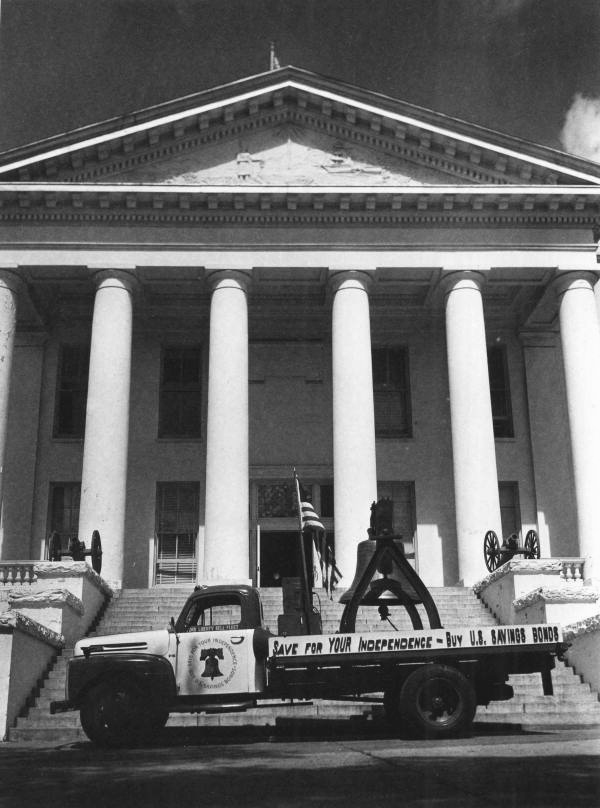
On June 6th, Florida’s bell paid its first visit to the city that would become its home. Displayed in the oldest part of the Capitol building, officials worried the 2,080-pound bell would seriously weaken the floor of the nearly century-old structure.
In Fort Lauderdale, the touring bell stirred up 50-year-old memories for piano tuner and composer W.E. PaDelford. In 1900, he was a member of the Standish Guards Drum & Bugle Corps. When the original Liberty Bell left Philadelphia for Massachusetts to take part in the Plymouth Rock Centennial celebration, two members of the corps were requested to stand as guards. PaDelford answered the call.
As Independence Day arrived, Floridians had purchased $9,017,325 in Savings Bonds — 109.1% of the state quota. Sales exceeded quotas in 44 of the state’s 67 counties.
At the Capitol on July 7th, Governor Fuller Warren accepted his state’s Liberty Bell before a crowd of more than 300. The 584th Air Force Band from Eglin Field Airbase performed patriotic marches as tiny children waved tiny American flags. When the ceremony ended, Warren grappled with the same question as many of his counterparts, what to do with a gift you didn’t ask for and can’t refuse?
The governor announced the bell would be placed in the Capitol lobby until a permanent location could be secured.
But by 1952, the bell had been quietly stored away, spending most of its time in a State Road Department warehouse. Upon request, it was lent to various cities for civic celebrations. The Florida Citrus Growers Association borrowed it for a promotional tour of the state.
Fearing it might quietly ease into obscurity, Commissioner of Agriculture Nathan Mayo suggested the erection of a concrete stand for the bell in R.A. Gray Park, on the south side of the Capitol. By this time, other capital cities had learned an undeniable fact about bells — they beg to be rung. It’s their one job. And people want to help them do their job. Mayo pragmatically suggested the clapper be wired down to prevent “mischievous boys” from ringing it.
Government moving at the pace of government, it would take another five years for the bell to find a permanent location. On October 30th, 1957, the state awarded a $5,977 contract to the Winchester Construction Company of Tallahassee to build a decorative concrete housing for the state’s Liberty Bell in Waller Park, between the Capitol and Supreme Court Building.
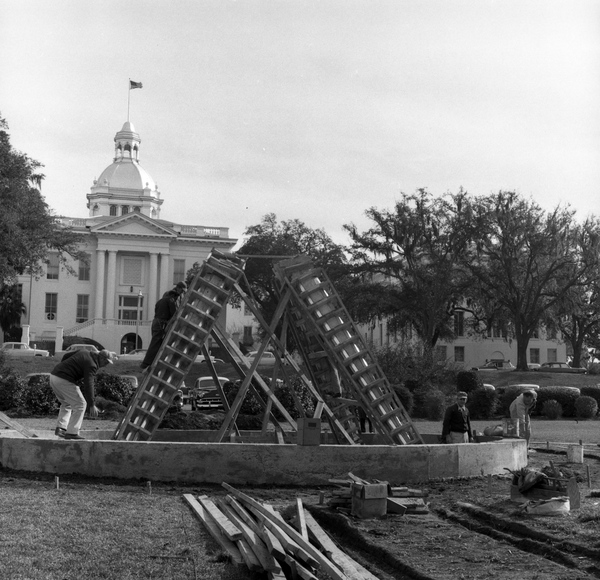
Winchester’s design seemed to solve several of the challenges faced by other states. The bell’s height would deter mischevious boys and curious tourists from ringing it. But with a rope and a ladder, it could easily toll on official occasions. And the raised display allowed the bell to peal out at full volume, reverberating for miles without deafening its ringers.
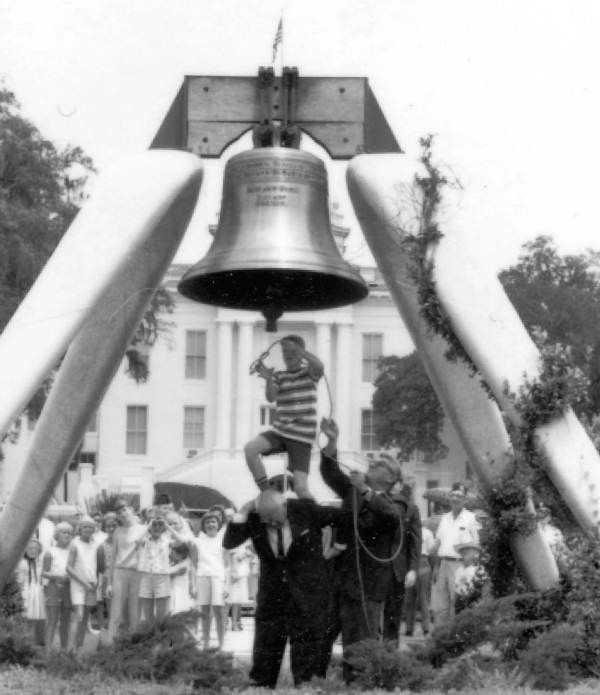
The new display was a resounding success. In 1963, President Kennedy launched the Ringing of the Bells campaign, calling for bells across America to ring out on Independence Day. Florida’s Liberty Bell answered the call. In 1966, it rang for 3 minutes straight. Two years later, nearly 2,000 people gathered around the shores of nearby Lake Ella as the Liberty Bell and bells across the city rang out in celebration.
But over time, the design of the bell stand proved less of a deterrent and more of a dare. The mischievous boys of the ’50s grew up to become the drunk FSU students of the ’60s. On more than a few occasions, the 3 a.m. silence of a sleepy capital city was cracked open by the unwanted toll of the Liberty Bell.
The permanence of the bell’s location grew spurious as the ’70s approached. The 1854 Capitol building had long been inadequate to serve the needs of 6.7 million citizens. A novel plan was drawn up to keep the government operating in the existing Capitol as a new complex was built around it on three sides. Upon completion, the old building would be razed.
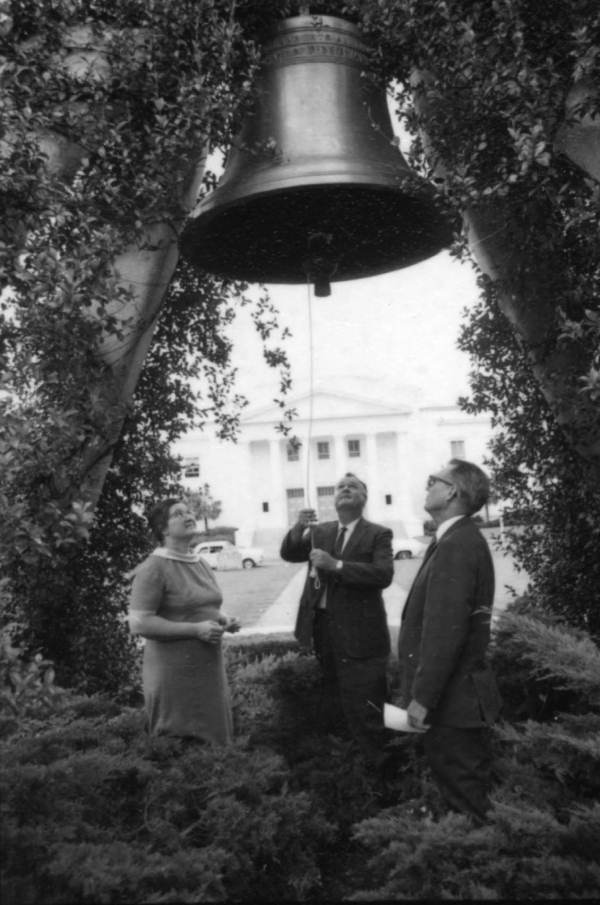
Waller Park, with its concrete Liberty Bell display now covered in creeping ivy, sat directly in the path of the new Capitol. The park was bulldozed in 1973, and the Florida Liberty Bell returned to mothballs, this time in the basement of the Archives, History, and Records Management Building.
The approaching 1976 Bicentennial and its accompanying wave of patriotic fervor kept the bell from being lost to time. In 1974, the Leon County Bicentennial Committee spent considerable political capital to get the bell included in plans for the new complex. Despite their best efforts, a location was not secured in time for Independence Day, and the bell remained silent.
The project would take five years and 43 million dollars to complete. Debuting in 1978, it remains the newest Capitol in the country. Throughout construction, a grass-roots effort to save the old Capitol steadily gained steam.
Instead of being bulldozed to make way for the planned grand concrete fountain, the old Capitol remained in place, dwarfed by its 22-story concrete office tower of a replacement and flanked by twin four-story office buildings, one for each house of Congress.
Contextual architecture is like the bass line in a song; it works best when you barely notice it. It just fits in. Everything feels right. When a new building is designed contextually, it feels in and of the space, not on the space. The Florida Capitol complex stands today as a shining example of the opposite of contextual architecture. It’s what happens when a plan doesn’t quite come together. Yet somehow, it’s perfectly Florida.
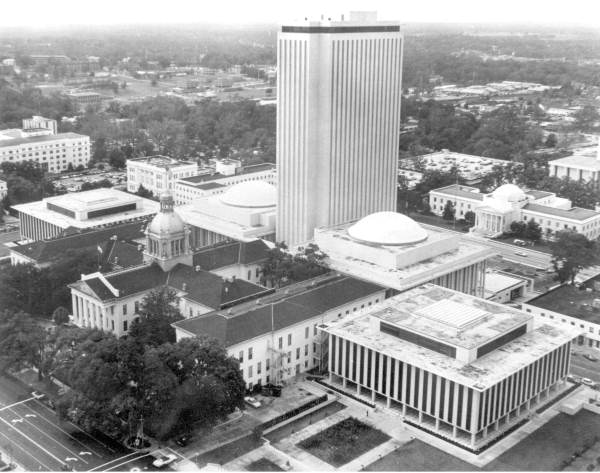
In a 1978 Tampa Bay Times article, Don Pride questioned the state’s spending, down to the dollar — specifically in the chambers of Congress, where legislators work 60 days out of the year. Focusing on Congress’ 160 leather chairs, each costing taxpayers $434, Pride opined, “Neither representatives nor senators need budge from those comfortable chairs in their respective chambers to talk to their aids back in their offices. Their chamber desks are equipped with cocoa brown princess telephones that cost taxpayers a total of $7,012 to install and $2,096 a month for their limited use between the members’ desks and their offices.”
But it wasn’t just government watchdogs and architecture snoots speaking out against the new Capitol Complex, Tallahassee’s fire chief joined the chorus with the most pressing concern. The tarpaper roof of the old Capitol was nearly touching the new building, leaving no room for a fire engine between the two buildings, should a fire break out in either. Given the condition of the old Capitol, this was more than just a code violation; it was a clear and present danger.
The old building ultimately won a permanent stay of execution by removing the north, south, east, and west wings, which had been added between 1923 and 1947. The new arrangement placated the fire department and made for a less snug fit between the old and new centers of government.
By 1982, the old Capitol was completely restored to its 1909 condition. It now operates as the Florida Historic Capitol Museum.
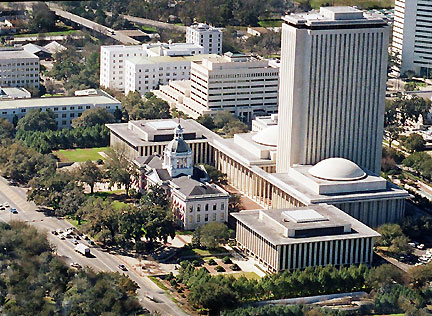
The new Capitol gradually fit in and went about performing the quiet day-to-day functions of government.
In the wee hours of the morning on June 14th, 1991, first responders were called to the Capitol — not the fire department, but the SWOT team. Drunk FSU student Marshall Ledbetter had broken a window, entered the main building and barricaded himself in the empty office of Wayne Todd, the State Senate’s Sergeant at Arms. The Florida man then faxed (it was 1991) his list of demands, not to police, but to local rock station Gulf 104.
The 22-year-old ordered 666 donuts for his “fine friends” on the local police forces, implored society to stop being automaton clones, and demanded to speak with Lemmy Kilmister, Ice Cube and others.
After several hours, Ledbetter was apprehended without injury and without the intervention of Lemmy.
Today, the Florida Capitol receives 200,000 annual visitors. A fraction of those might walk past the House Office Building and notice the state’s Liberty Bell sitting silently on a concrete slab, stripped of its clapper and yoke.
A bronze plaque from 1974 dedicates the bell to the spiritual enrichment of the people of Florida. The House of Representatives and Bicentennial Commission congratulate themselves for placing the bell here, where citizens can see it and reflect (silently) on the liberty it symbolizes.*
But if the Florida Liberty Bell could still talk, there would be a lot more to the story.
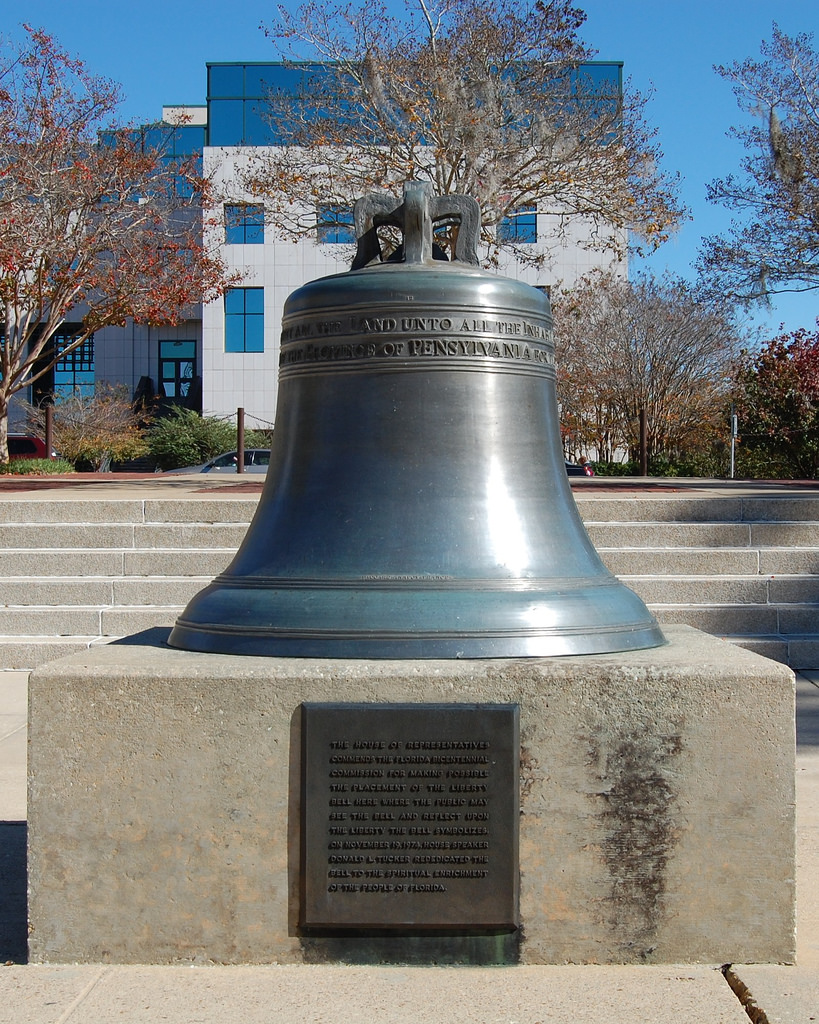

*As of December 2021, the plaque no longer accompanies the Liberty Bell. The Capitol complex is undergoing an extensive renovation project. Hopefully, the Liberty Bell stays put.

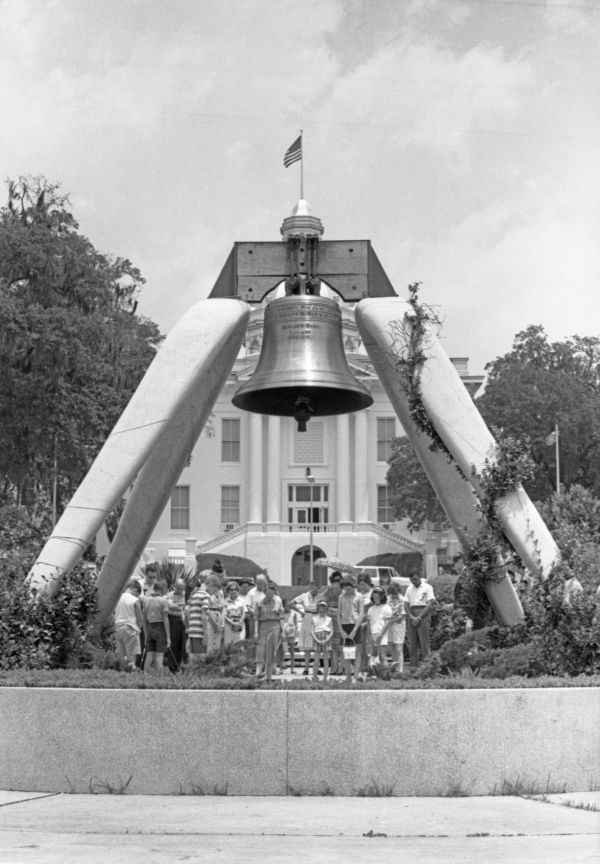
The plaza where the bell rests has been remodeled. The plaque is no longer with the bell (as of Dec 2021).
William,
Thanks for the news. I’ve updated the article. Hopefully the bell remains on display.
Was the bell out though? And where (if it was)? We went in 2020 and the bell was in storage… thanks so much!
Julia,
Thanks for the comment. Sorry you missed the bell. I missed a few in 2020 myself. When I wrote this in January 2020 the bell was in Waller Park, east of the House Office Building. I was in the area in February 2022 and checked with Capitol tour staff who told me the bell was accessible. That might have changed with ongoing construction. I do see a note on the Capitol Construction Closure page saying the Perimeter of Waller Park is fenced off for the duration of the project. Definitely call to confirm accessibility before arranging a visit: (850) 488-6167. And please do let me know what you find out. Happy bell hunting!